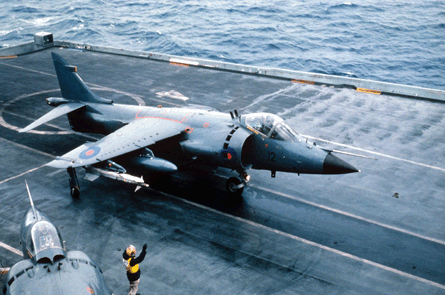Royal Navy Cdr Nigel "Sharkey" Ward and the Royal Air Force's David Morgan gained their place in British military folklore by flying the navy's British Aerospace Sea Harrier FRS1 fighter with distinction during the 1982 Falklands War.
Flight International's UK test pilot Peter Collins offers a rare insight on flying the "SHAR", having sailed south aboard the rapidly completed aircraft carrier HMS Illustrious as the combat action drew to a close.
Freshly posted to Germany as an RAF Harrier GR3 ground-attack pilot, Collins was recalled to the UK after the war broke out and diverted to the Fleet Air Arm for a short tour flying the Sea Harrier. Type conversion was conducted with 899 NAS at RNAS Yeovilton in Somerset between June and July 1982.
"My first memory is of my first FRS1 familiarisation flight, including 'Ski Jump' launch," says Collins. "The FRS1 cockpit wasn't like the GR3's at all, with the engine and critical aircraft systems instrumentation on the left [rather than the right], to allow space for the Blue Fox radar display. There was no Sea Harrier T-Bird [two-seat trainer] and no simulator training; just a quick cockpit self-assessment in the last FRS1 left in the UK. And then go: taxi up to the very bottom of the ramp, gaze upwards at what looked like Mount Snowdon (the ramp was set at the maximum angle of around 18°), remember some words of wisdom from somewhere, pause, slam the throttle, depart the lip, take nozzles and fly away. Piece of cake!"
 |
|---|
© Rex Features/John W Jockel |
Collins then moved aboard HMS Illustrious - aka "Lusty" - with 809 NAS for the voyage to the South Atlantic. The vessel arrived in the Falkland Islands Protection Zone in late August, with its SHARs flying combat air patrol sorties to plug a gap until a new landing strip could be completed for the RAF.
Recalling one experience, Collins says: "It was a perfect day, but Lusty was heaving in a massive swell and the flight deck was pitching through 6°. I manoeuvred into my launch position while Flyco [Flying Co-ordination] had a think about it. Through my forward canopy the entire world alternated from completely bright blue to completely bright green (the sea was alive with plankton) as the ship pitched through more angles than I had ever seen before. Refusing the launch is mutiny: it has to be done by the pilot slamming the throttle as the deck starts to pitch down. Thankfully Flyco scrubbed the launch!" Illustrious returned home after two months of duty, with Collins having logged a total of 66 deck landings.
"I am immensely proud of my short time with the Fleet Air Arm," says Collins. "I wish them every continued success as a uniquely professional element of our fighting services."
The air defence of the Falklands remains a key responsibility of the UK armed forces. RAF McDonnell Douglas F-4F Phantoms began providing cover after the 1982 conflict, with Panavia Tornado F3s now on duty. Mount Pleasant air base is expected to later this year become the first overseas location to host an operational deployment of the service's Eurofighter Typhoon.
Source: Flight International























